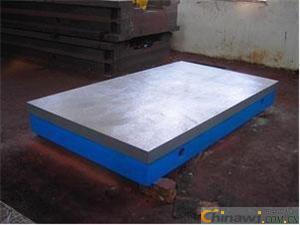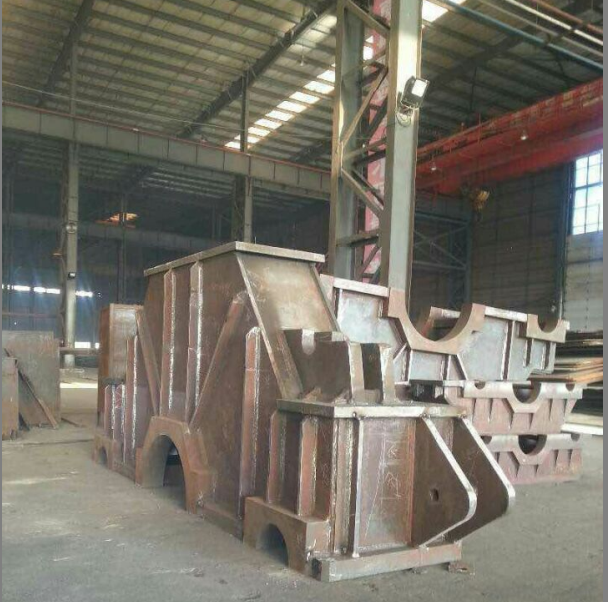The cast iron platform is also known as the cast iron plate and the cast iron platform. The main appearance of the cast iron platform is the box type. The working surface is generally divided into a square working surface and a rectangular working surface.
The cast iron platform is also known as the cast iron flat plate and the cast iron platform. The main appearance of the cast iron platform is the box type. The working surface is generally divided into a square working surface and a rectangular working surface. The cast iron platform is in a platform with an accuracy level lower than “00â€. On the working surface, at the same time, sand holes with a diameter of less than 14mm are allowed to be blocked by the same material, but the hardness needs to be lower than the hardness of the surrounding material. Generally, the cast iron platform with high quality is allowed to have sand holes, cracks and pores on the working surface. For defects such as slag inclusions and shrinkage, the manufacturer should remove the surface of the cast surface while the surface should be kept flat and the paint surface is firm. Because the flat plate is the only flat reference device for workpiece inspection or scribing, the plate must be properly adjusted, and the working environment temperature should be kept at around 20 degrees, while avoiding the occurrence of vibration.
The cast iron platform can be divided into cast iron platform and granite platform according to the material. The cast iron platform can be used in various occasions to check the dimensional accuracy and shape deviation of the parts. The cast iron platform is an indispensable basic tool in the mechanical manufacturing industry. One of them, the strength and hardness of the cast iron platform must be good enough, and durability is the most important. Brief Discussion on Maintenance Specification for Cast Iron Plate/Cast Iron Platform Inspection Gauge
In production, the measuring tool is like a weapon in the hands of the inspector. If the weapon is in a semi-defective state or damaged state, then the test result has no meaning, and the quality of the product is not supervised and controlled, so the maintenance and care of the gage is very important.
Here are the maintenance specifications for several measuring tools (for commonly used testing tools):
1. Do not use the oil stone or abrasive cloth to rub the surface of the measuring instrument and the measuring surface and the marking part. Non-metering maintenance personnel are strictly prohibited to disassemble, modify and repair the measuring tool without authorization.
2. The measuring tools should be kept clean and dry, free from vibration and corrosive gases, and away from places with large temperature variations or places with magnetic fields. The measuring instruments stored in the measuring box should be clean and dry, and no other debris should be stored.
3. Do not touch the measuring surface of the measuring instrument by hand, because the wet dirt such as sweat on the hand will contaminate the measuring surface and make it rust. Do not mix the gauge with other tools and metal materials to avoid bumping the gauge.
4. After using the measuring tool, wipe off the surface stains and aluminum chips, and loosen the fastening device. When it is not used for a long time (more than one month), apply anti-rust oil to the measuring surface. When the measuring tool is not in use, it should be placed in a protective box. It is best to use it exclusively for full-time use, and make an annual review record of the measuring instrument by the authoritative unit. 5. Do not use the caliper's claw tip as a stylus, compass or other tool. Do not twist the two jaws or use the gauge as a card.
6. When there is burr on the surface of the workpiece, be sure to remove the burr, and then measure, otherwise the gauge will be worn, and the accuracy of the measurement will be affected. The accuracy of the cast iron platform is generally guaranteed by manual scraping. The effect of depth on the service life of cast iron plates is not negligible.
The JJG117-91 verification procedure does not specify the depth of scraping, which is undoubtedly a defect. From the point of view of use, the contact area can be increased as much as possible without causing the workpiece to be combined with the cast iron plate, and the service life of the cast iron table can be improved. The JJG117-91 verification procedure also does not properly limit this item. In order to improve the service life of the cast iron table and ensure its working accuracy, it is recommended to have a depth of 0.02mm or more for the scraping depth, which ensures a long service life and verification cycle of the cast iron table.
Zhonghua Foundry specializes in the production of cast iron flat plates, cast iron platforms, inspection plates, scribing plates, good material quality, high precision and long service life.
Http://news.chinawj.com.cn Submission:
Submission: 
The cast iron platform is also known as the cast iron flat plate and the cast iron platform. The main appearance of the cast iron platform is the box type. The working surface is generally divided into a square working surface and a rectangular working surface. The cast iron platform is in a platform with an accuracy level lower than “00â€. On the working surface, at the same time, sand holes with a diameter of less than 14mm are allowed to be blocked by the same material, but the hardness needs to be lower than the hardness of the surrounding material. Generally, the cast iron platform with high quality is allowed to have sand holes, cracks and pores on the working surface. For defects such as slag inclusions and shrinkage, the manufacturer should remove the surface of the cast surface while the surface should be kept flat and the paint surface is firm. Because the flat plate is the only flat reference device for workpiece inspection or scribing, the plate must be properly adjusted, and the working environment temperature should be kept at around 20 degrees, while avoiding the occurrence of vibration.
The cast iron platform can be divided into cast iron platform and granite platform according to the material. The cast iron platform can be used in various occasions to check the dimensional accuracy and shape deviation of the parts. The cast iron platform is an indispensable basic tool in the mechanical manufacturing industry. One of them, the strength and hardness of the cast iron platform must be good enough, and durability is the most important. Brief Discussion on Maintenance Specification for Cast Iron Plate/Cast Iron Platform Inspection Gauge
In production, the measuring tool is like a weapon in the hands of the inspector. If the weapon is in a semi-defective state or damaged state, then the test result has no meaning, and the quality of the product is not supervised and controlled, so the maintenance and care of the gage is very important.
Here are the maintenance specifications for several measuring tools (for commonly used testing tools):
1. Do not use the oil stone or abrasive cloth to rub the surface of the measuring instrument and the measuring surface and the marking part. Non-metering maintenance personnel are strictly prohibited to disassemble, modify and repair the measuring tool without authorization.
2. The measuring tools should be kept clean and dry, free from vibration and corrosive gases, and away from places with large temperature variations or places with magnetic fields. The measuring instruments stored in the measuring box should be clean and dry, and no other debris should be stored.
3. Do not touch the measuring surface of the measuring instrument by hand, because the wet dirt such as sweat on the hand will contaminate the measuring surface and make it rust. Do not mix the gauge with other tools and metal materials to avoid bumping the gauge.
4. After using the measuring tool, wipe off the surface stains and aluminum chips, and loosen the fastening device. When it is not used for a long time (more than one month), apply anti-rust oil to the measuring surface. When the measuring tool is not in use, it should be placed in a protective box. It is best to use it exclusively for full-time use, and make an annual review record of the measuring instrument by the authoritative unit. 5. Do not use the caliper's claw tip as a stylus, compass or other tool. Do not twist the two jaws or use the gauge as a card.
6. When there is burr on the surface of the workpiece, be sure to remove the burr, and then measure, otherwise the gauge will be worn, and the accuracy of the measurement will be affected. The accuracy of the cast iron platform is generally guaranteed by manual scraping. The effect of depth on the service life of cast iron plates is not negligible.
The JJG117-91 verification procedure does not specify the depth of scraping, which is undoubtedly a defect. From the point of view of use, the contact area can be increased as much as possible without causing the workpiece to be combined with the cast iron plate, and the service life of the cast iron table can be improved. The JJG117-91 verification procedure also does not properly limit this item. In order to improve the service life of the cast iron table and ensure its working accuracy, it is recommended to have a depth of 0.02mm or more for the scraping depth, which ensures a long service life and verification cycle of the cast iron table.
Zhonghua Foundry specializes in the production of cast iron flat plates, cast iron platforms, inspection plates, scribing plates, good material quality, high precision and long service life.
Http://news.chinawj.com.cn
 Submission:
Submission: 
With a modern factory size over 60,000 m2,
and qualified industrial engineers, Zhongda is able to manufacture complex and
large steel industrial components, such as sintering machine, tunnel boring
machine, etc. The factory has single component lifting ability of 100 tone, and
combined with the functions of assembling, welding, testing, painting etc. All
pressure components are 100% X-ray texted quality control is carried out
through all procedures.
Steel Components,Metal Building Components,Sheet Metal Components,Steel Building Components
Zhongda Steel Structure , http://www.zhongdametal.com